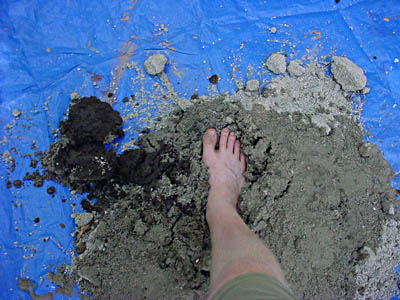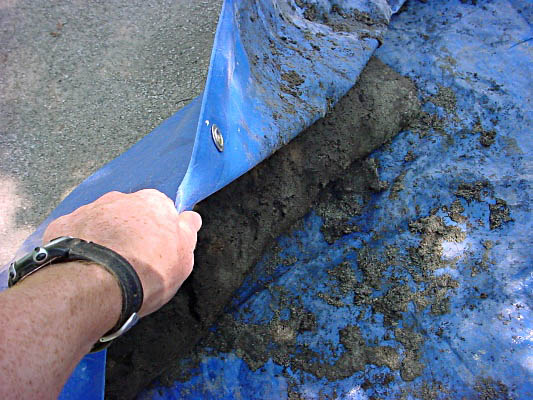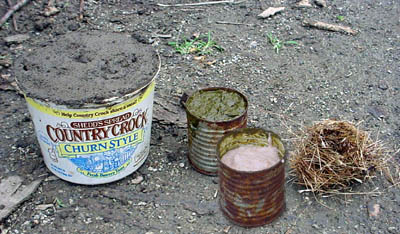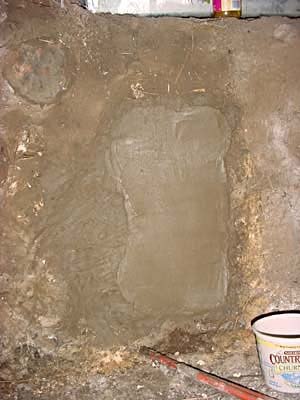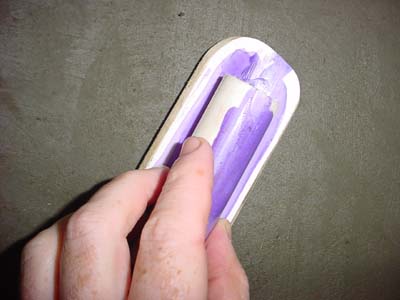Earth Plaster: Difference between revisions
No edit summary |
No edit summary |
||
| Line 1: | Line 1: | ||
=Rough Earth Plaster for Cordwood Wall= | =Rough Earth Plaster for Cordwood Wall= | ||
=Purpose= | |||
To give the walls a nearly smooth surface in preparation for final plaster. Final plaster does not perform well over gaps larger than 1 cubic inch. | |||
==Ingredients== | ==Ingredients== | ||
Revision as of 17:06, 17 August 2008
Rough Earth Plaster for Cordwood Wall
Purpose
To give the walls a nearly smooth surface in preparation for final plaster. Final plaster does not perform well over gaps larger than 1 cubic inch.
Ingredients
(same ingredients as cob) 5 gallons of submerged mud from the duck pond 5 gallons of crushed lime half a wheel barrell of straw (fluffed not compressed)
Making the Plaster
Chose a work area that was flat and shady Cleared work area of large rocks and sticks Spread tarp Dumped mud and lime on a tarp Stomped and rolled the mixture until it became homogenous
Added straw gradually as I continued to stomp and roll
Covered the plaster with the tarp to keep it fresh while I prepped the wall
Note: I kept the mixture as dry as possible. But at one point I had to add some water because it got so hard that I couldn't stomp it
Preparing the Wall
Determined which ends to keep visible (keepers) and which to bury
Scraped the keepers with a trowel 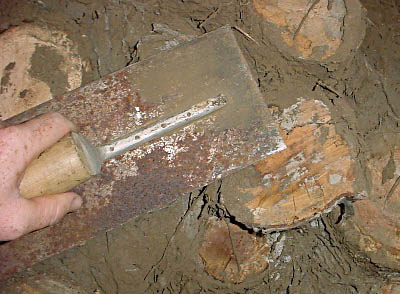 Brushed the keepers with a wire brush
Brushed the keepers with a wire brush 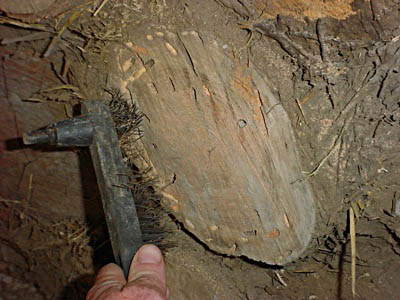 Oiled the keepers with linseed oil
Oiled the keepers with linseed oil 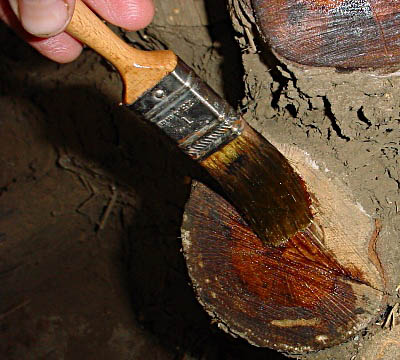 Pre-Soaked the wall heavily with a spray bottle (Critical)
Filled a five-gallon bucket half full with plaster and brought it over to the wall
Pre-Soaked the wall heavily with a spray bottle (Critical)
Filled a five-gallon bucket half full with plaster and brought it over to the wall
Plastering
My understanding is that difference between "cob" and "rough plaster" is how they are used. When used structurally it is referred to as "cob" and when used cosmetically it is referred to as "rough plaster".
Most important factor: Spray as you go. In between each handful of plaster I re-soaked the wood and cob in the immediate area where that particular handful of plaster would be placed.
The motions necessary to work the plaster onto a vertical surface naturally leaves a smooth surface. I left dibbles in the surface of the plaster so that the final plaster will have plenty to grab onto. Dibbles.jpg
Objectives:
To fill any gaps that were more than 1" deep 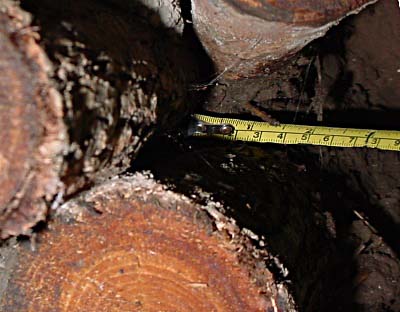 To cover all the rounds except the keepers
To cover all the rounds except the keepers 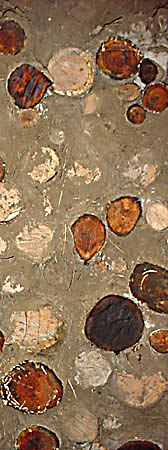
 To keep the rough plaster 1/2 inch back from the keepers' edges so that the final plaster will finish flush Keepers edge.jpg
To keep the rough plaster 1/2 inch back from the keepers' edges so that the final plaster will finish flush Keepers edge.jpg
Recommendations / Suggestions / Ideas to try
Select keepers well in advance and finish them with lacquer before attempting any rough plastering. Lacquer is better than oil because it protects wood against boring beetles, does not have to be re-applied every six months, and provides a smooth surface which is easier to clean. Dirty keepers are hard to clean and often too difficult to clean completely. Choosing the keepers and lacquering them before plastering could help with these issues.
Ask lumber companies for the tarps that they throw away every day - these are great for stomping plaster
In general, choose keepers based on how far they stick out. Keepers that protrude farther than the surrounding rounds are the easiest to plaster around.
Finish Earth Plaster to cover interior of cordwood / earthbag structure
Attempt 1
-Travis Toon
Ingredients
1500 ml sifted soil, hydrated to a gel/paste like consistency. Gathered subsoil (16 inches deep) from near the well. Hydrated the soil and sifted it using 1/8" screen.
200 ml fresh cow manure. So fresh there was still steam rising off the top. I am told freshness is not necessary, but that composted manure is worthless.
180 ml wheat paste. Added whole wheat flour and cold water in a pan. Stirred together well. Then heated until pasty. Add immediately. I ate the leftovers which were quite tasty.
Handful of micro straw. This particular grass was found above the tent site 10-15 ft short of the property line near the goat fence. Chopped into 1" lenghths. Did not include roots or seed stalks.
Procedure
Mixed together above ingredients by hand until homogenous.
Chose an area that was relatively smooth and void of large holes. Areas with holes much larger than 2" wide by 1" deep should probably be prepared with a rough plaster mix, i.e. cob.
Pre-soaked the area to be plastered. Waited 20 minutes for water to penetrate old cob.
Made a slurry. Took 10% of the plaster and mixed it with water in a separate bowl so that it would go on very thin.
Re-wet the area immediately before applying slurry.
Applied (smeared) slurry with hand approximately 1/16" thick.
Applied plaster about 1/2" thick by hand over the slurry. The plaster was very easy to work with.
Troweled the area. The tool for this was improvised from a piece of 6" diameter PVC pipe fitted with a 1" PVC handle.
12 hours later smoothed out the trowel lines. The tool for this was a lid from a medium sized yogurt container. Used a pair of scissors to cut off the outer edge of the lid.
Attempt 2
Ingredients
800 ml sifted soil, hydrated to a gel/paste like consistency. Gathered soil from edge of the duckpond. Since the soild was naturally hydrated, it was easy to sift using the 1/8" screen.
800 ml sifted sand. Used the same 1/8" screen for sifting.
200 ml fresh cow manure.
180 ml wheat paste. Added whole wheat flour and cold water in a pan. Stirred together well. Then heated until pasty. Add immediately.
Two handfuls of micro straw. This particular grass was found above the tent site 10-15 ft short of the property line near the goat fence. Chopped into 1" lenghths. Did not include roots, but got lazy and let some seed stalks in.
Procedure
Mixed together above ingredients by hand until homogenous.
Chose an area that was relatively smooth and void of large holes. Areas with holes much larger than 2" wide by 1" deep should probably be prepared with a rough plaster mix, i.e. cob.
Pre-soaked the area to be plastered. Waited 20 minutes for water to penetrate old cob.
Made a slurry. Took 10% of the plaster and mixed it with water in a separate bowl so that it would go on very thin.
Re-wet the area immediately before applying slurry.
Applied (smeared) slurry with hand approximately 1/16" thick.
Applied plaster about 1/2" thick by hand over the slurry. The plaster was very easy to work with.
Troweled the area. The tool for this was improvised from a piece of 6" diameter PVC pipe fitted with a 1" PVC handle.
